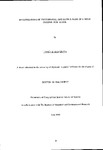INVESTIGATIONS OF PREFERENTIAL AND MATRIX FLOW IN A MOLE DRAINED SOIL BLOCK
| dc.contributor.author | DEEKS, LYNDA KAREN | |
| dc.contributor.other | School of Geography, Earth and Environmental Sciences | en_US |
| dc.date.accessioned | 2013-09-24T11:07:40Z | |
| dc.date.available | 2013-09-24T11:07:40Z | |
| dc.date.issued | 1995 | |
| dc.identifier | NOT AVAILABLE | en_US |
| dc.identifier.uri | http://hdl.handle.net/10026.1/1925 | |
| dc.description.abstract |
An innovative research study was established at IGER, North Wyke, Devon, to investigate preferential flow through a poorly structured relatively impermeable soil. Macropore channels were added by a mole plough in order to investigate soil water pathways and chemical transport in a soil in which preferential flow was guaranteed. The investigation focused on water and solute movement through specific flowpaths, namely macropores and mesopores, and the interaction between mobile and immobile zones within the soil. Two large soil blocks (1 m2 by 0.85 m) of the Hallsworth series were removed from the field and placed on sand tables so that a suction could be induced at the base of the soil block. The edge was sealed using paraffin wax. Eight tensiometers and suction cup lysimeters were installed in each block together with fifteen pairs of time-domain reflectometry wave guides. A regular spacing pattern was employed so that spatial variations could be easily identified. Samples were collected from suction cup lysimeters every 4 hours. Soil water status was observed from the TDR probes daily and from tensiometers every 10 minutes. Five tracer experiments were conducted; three involved the miscible displacement of chloride at concentrations of 100 and 250 mg I"' and two used nitrate (500 mg l ') and chloride (2500 mg 1') applied as a pulse. Tracer and irrigation water was applied through a misting system at an irrigation rate of 2.76 mm h-1. Three techniques were used to examine soil structure in the macropore and mesopore pore size range to investigate potential flowpaths in more detail. The profile tracing method (PTM). binary transect method (BTM) and resinated core section method (RCSM) provided useful quantitative structural information. Soil water status averaged over a large sampling volume (TDR, 1540000 mm3) was considered to be stable through time. Detailed observations of soil water suction using tensiometers showed that soil water conditions remained unsaturated, at approximately 10 to 20 cm H2O, and varied by 3 cm H2O throughout the experiment. Suction varied depending on the location of each tensiometer with respect to position within or between aggregates. Results based on Poiseuille's law and suction data showed that the flowpaths were predominantly mesopores. This result was supported by breakthrough curve analysis for the bulk of the soil although macropore flow was observed towards the mole drain. Flow rates observed from tracer movement varied throughout the soil regardless of depth. Chloride moved quickly towards the mole drain and the arrival of tracer was recorded within 4 hours. Time to breakthrough monitored at the suction cups varied from 4 to 76 hours. When the concentration gradient between applied solute and antecedent solute was large, reduced time to attain peak concentration was noted. As the concentration gradient reduced, speed of rise to peak concentration increased. An advection-dispersion model (CLEARY) fitted change in observed solute concentration through time at the suction cup lysimeters well. The study concluded that although water moved rapidly through the soil, the tortuous nature and increased contact with soil particles encountered as water moved through the mesopores resulted in water with matrix flow solute characteristics. | en_US |
| dc.description.sponsorship | The Institute of Grassland and Environmental Research | en_US |
| dc.language.iso | en | en_US |
| dc.publisher | University of Plymouth | en_US |
| dc.title | INVESTIGATIONS OF PREFERENTIAL AND MATRIX FLOW IN A MOLE DRAINED SOIL BLOCK | en_US |
| dc.type | Thesis | |
| plymouth.version | Full version | en_US |
| dc.identifier.doi | http://dx.doi.org/10.24382/4575 | |
| dc.identifier.doi | http://dx.doi.org/10.24382/4575 |
Files in this item
This item appears in the following Collection(s)
-
01 Research Theses Main Collection
Research Theses Main


